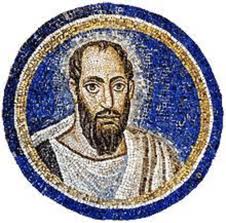

Of course you will understand that this diagram which we have been considering does not actually represent Paul's thought. For one thing the diagram is a plane, two-dimensional, while Paul's thought, viewed as an organism, is three-dimensional. Therefore if we are even to approximate the structure of the thought, we must imagine the diagram as having a solid form with length, breadth, and thickness. It would then be a working model instead of a picture. The nucleus is the throbbing heart. The orbits about it are not single line tracks, but living sheaths. The radiations are not like little projectiles, but are waves of consuming fire.
Even this would not be adequate correspondence; I don't think Paul can be pinned down in a diagram of any sort. I have used this diagram only as a means to an end, to give some sort of concreteness to my words. When we enter the life, as Paul entered into it, diagrams are meaningless; but at least this may be the sort of a figure that will show graphically that we cannot simply and easily say, "Oh, Paul is just using a lot of words without rhyme or meaning." There is a meaning; there is a structure. And to that extent the diagram is useful. It is not by chance that it takes the appearance of an atom or solar system. Every organism is a simulacrum of the universe. That is what being made in the image of God means. Our conception of the atom and the universe may change, is changing. But this does not mean that our diagram is false. It is true, relative to our present capacity of understanding.
I am reminded of Socrates again. In the Phaedo he had been explaining at some length about the soul and its future habitation, very definitely and concretely, almost as concretely and specifically as Swedenborg. When he had finished he said:
"Now it would not be fitting for a man of sense to maintain that all this is just as I have described it, but that this or something like it is true concerning our souls and our bodies, since the soul is shown to be immortal, I think we may properly and worthily venture to believe."
Then he says:
"For the venture is well worth while."
Paul wanted his readers to try an adventure in experience. We must not think that he was setting intellectual traps, trying to show his erudition, or putting his thought in a complicated form which would flatter the perspicacity of the Romans. He was doing what he did simply because he had to. There are some things in which we cannot follow our usual logical processes. I am going to refer once more to our Eddington. Speaking of spiritual activity, he says:
"There is a hiatus in reasoning, but it is hardly to be described as a rejection of reasoning. There is the same hiatus in reasoning about the physical world, if we go back far enough. We can only reason from data, and the ultimate data must be given to us by a non-reasoning process, a self-knowledge of that which is in our consciousness. To make a start, we must be aware of something, but that is not sufficient. We must be convinced of the significance of that awareness."
"Awareness," says Eddington. "Know thyself," says Socrates. "I see in my body the war of the members," says Paul. He did not think he would accomplish anything at all in his writings unless in some way, he induced that state. That is what he is trying to do. And that is why he used a method which, we may say, to the Jews is a stumbling block, to the Greeks foolishness. It can only be understood in one way, by entering in. It is like Paul's faith in Christ, it has to be lived from the inside; and that life is the death of the old life.